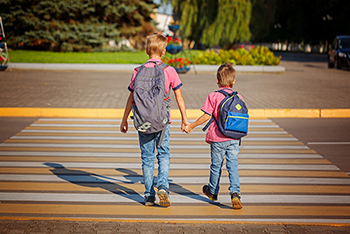With the kids heading back to school, here are some tips to help keep them safe and sound while they readjust to a new routine after the summer break.
Chips and pop are not food groups – healthy eating at school
Although healthy eating is something we should do all the time, kids may get into bad habits during summer break, when they have more freedom to choose their own snacks. Back to school is a good time to get the kids back into healthy eating habits.
Without resorting to clichés, breakfast IS pretty important, so start the day off right with a breakfast that includes plenty of protein and fibre, and not too much added sugar. Note that a lot of foods that are marketed as hearty breakfasts may have more sugar than is healthy for your kids. Read the nutritional information on the package. Otherwise, you can’t go wrong with fruit, whole-grain toast and eggs. Try two eggs with only one yolk for a healthier alternative.
In terms of what you send with them for lunch and snacks, here are a few suggestions:
- Skip the packaged drinks that are high in sugar. Water is the best drink, and in fact juice is almost as high in sugar as pop.
- Likewise, avoid pre-packaged lunches and snacks that are typically high in sugar, salt, fat, or all-of-the-above.
- Tip: when you make dinner, make a point to have an extra portion or two for tomorrow’s lunch. That way, you control what’s in their lunch.
- Fruits and veggies are good snacks, as are yogurt and nuts (in moderation)
- Avoid letting your kids buy their lunches at school, as most options are not likely to be healthy.
- Portion control is important. If you’re worried that your kids will get hungry at school, you can’t go wrong packing extra fruit.
Safe travel to & from school
Even older students need to review safety rules when it comes to getting to and from school.

If your child takes a school bus, they should:
- Always wait until the bus comes to a full stop before approaching from the curb.
- If they have to cross the street, cars are supposed to stop, but remind your kids to look both ways anyway, to be safe.
- When on the bus, students should remain seated as much as possible, and use safety belts if they are provided.
If you think your child is ready to walk to school (typically age 9 and up), think about the following:
- Teach your child the route before school starts (walk it with them a few times)
- Ensure there are adult crossing guards anywhere they need to cross the street.
- Tip: Find out if there are other children in your neighbourhood who are also walking. Walking in groups of two or more is safer.
- Try to make sure your kids wear brightly-colored clothing or reflectors on their outerwear or backpack so that drivers are more likely to see them, especially when weather makes visibility an issue.
A backpack is not a storage locker
A lot of parents report that their kids’ backpacks are always jam-packed, and quite heavy. This often reflects their workload, but there are a few things you can do to make sure your kids’ backpacks are not causing them discomfort, pain, or worse…
- Obviously, lighter is better, and experts say your child’s backpack should not weigh more than 15% of the child’s weight.
- Kids may forget to go through it, so maybe you can help. If there are books or other materials that they don’t need that day, keep them at home or in a locker (if applicable).
- Weight distribution also matters. Heavier items should go towards the inside of the backpack, and lower if possible.
If you’re buying new backpacks, wider straps are better. Adjust the length of the straps so the bottom of the backpack is at your child’s waist. And remind your kids to use both straps. Carrying a heavy backpack over one shoulder can lead to back and shoulder pain, and possibly longer-term problems. Depending where you live, a rolling pack may be an option, but remember that stairs and snow can be a problem.
Taking medication at school
If your child takes medication on an ongoing basis for asthma, diabetes or some other chronic condition, or if they require an epi-pen for severe allergies, make sure that you talk to the school well in advance of day one, and get your ducks in a row.
For tips on creating a school emergency medication plan, see our blog: Back to school medication tips – preparing an emergency medication plan
School boards require signed consent from you and your child’s doctor to administer medication. The board will likely have standard forms for you to fill out and return.
Remember, medication should be sent in the original container, with a label showing the student’s name, prescribing doctor, dosing info etc. If you ask, your pharmacy should be able to provide an extra container for school.
If your child is old enough, try to teach them about their own dosing schedule, so they can alert the teacher/nurse if a dose is missed etc.
Back to school is an exciting time, but can also create anxiety for parents. Following the above tips may help to put your mind at ease as you send your little ones out into the world.
